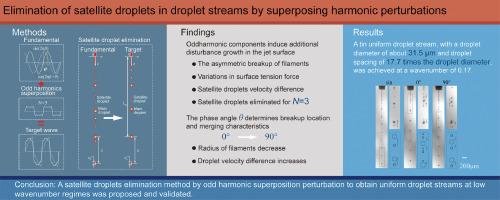Elimination of satellite droplets in droplet streams by superposing harmonic perturbations
IF 7.1
1区 工程技术
Q1 ENGINEERING, MECHANICAL
International Journal of Mechanical Sciences
Pub Date : 2024-09-11
DOI:10.1016/j.ijmecsci.2024.109723
引用次数: 0
Abstract
In tin-droplet laser-produced plasma sources, uniform droplet streams with large droplet spacing are desired to minimize the interference of explosion on neighboring droplets. Such droplet streams can be generated in low wavenumber regimes. However, satellite droplets easily appear among main droplets in those regimes, resulting in plenty of undesirable debris. Herein, a novel odd harmonic superposition perturbation method is proposed to eliminate satellite droplets and enhance droplet spacing of uniform droplet streams. The superposition number (N) and the phase difference (θ) of odd harmonic perturbations are adjusted to facilitate the coalescence of satellite droplets with main droplets. First, the superposed odd-order harmonic components could induce additional disturbance growth in jet surfaces, and finally lead to the asymmetric necking on filaments formed between two adjacent main droplets, featured as various carrot-shaped configurations. This asymmetric necking will cause unbalanced surface tension forces at the two sides of filaments, resulting in a velocity difference between satellite and main droplets. Based on this principle, by setting N and k to 3 and 0.2, respectively, satellite droplets positioned above main droplets accelerate, while those below decelerate, achieving complete coalescence between main and satellite droplets. Furthermore, the phase difference is found to determine the jet breakup location and satellite droplet merging characteristics. As θ varies from 0° to 90°, the droplet size significantly decreases while the droplet spacing remains constant since the perturbation energy increases. The merge direction of satellite droplets reverses from upward to downward due to enhanced unbalanced surface tension forces and velocity differences. As θ continuously increases to 270°, the droplet size further decreases along with a slight decrease in droplet spacing. Finally, by setting N = 3 and θ = 0°, mono-disperse tin droplet streams with a mean diameter of 31.5 μm and a maximum droplet spacing-to-diameter ratio of 17.7 are successfully formed. This work presents a novel approach for eliminating satellite droplets to achieve uniform tin droplet streams with large droplet spacing without increasing the droplet diameter.

通过叠加谐波扰动消除液滴流中的卫星液滴
在锡液滴激光产生的等离子体源中,需要具有大液滴间距的均匀液滴流,以尽量减少爆炸对邻近液滴的干扰。这样的液滴流可以在低波长条件下产生。然而,在这种情况下,主液滴中很容易出现卫星液滴,从而产生大量不良碎片。本文提出了一种新型奇次谐波叠加扰动方法来消除卫星液滴,并增强均匀液滴流的液滴间距。通过调整奇次谐波扰动的叠加数(N)和相位差(θ)来促进卫星液滴与主液滴的凝聚。首先,叠加的奇次谐波分量会在射流表面诱发额外的扰动增长,并最终导致相邻两个主液滴之间形成的丝状物出现不对称缩颈,表现为各种胡萝卜状构型。这种不对称缩颈会导致丝状物两侧的表面张力不平衡,从而造成卫星液滴和主液滴之间的速度差。根据这一原理,将 N 和 k 分别设置为 3 和 0.2,位于主液滴上方的卫星液滴会加速,而下方的液滴会减速,从而实现主液滴和卫星液滴的完全聚合。此外,还发现相位差决定了射流破裂位置和卫星液滴合并特征。当 θ 从 0° 变化到 90° 时,液滴尺寸显著减小,而液滴间距保持不变,因为扰动能量增加了。由于不平衡表面张力和速度差的增强,卫星液滴的合并方向从向上逆转为向下。随着 θ 不断增大到 270°,液滴尺寸进一步减小,液滴间距也略有减少。最后,通过设置 N = 3 和 θ = 0°,成功形成了平均直径为 31.5 μm、最大液滴间距直径比为 17.7 的单分散锡液滴流。这项研究提出了一种消除卫星液滴的新方法,从而在不增加液滴直径的情况下实现具有大液滴间距的均匀锡液滴流。
本文章由计算机程序翻译,如有差异,请以英文原文为准。
求助全文
约1分钟内获得全文
求助全文
来源期刊

International Journal of Mechanical Sciences
工程技术-工程:机械
CiteScore
12.80
自引率
17.80%
发文量
769
审稿时长
19 days
期刊介绍:
The International Journal of Mechanical Sciences (IJMS) serves as a global platform for the publication and dissemination of original research that contributes to a deeper scientific understanding of the fundamental disciplines within mechanical, civil, and material engineering.
The primary focus of IJMS is to showcase innovative and ground-breaking work that utilizes analytical and computational modeling techniques, such as Finite Element Method (FEM), Boundary Element Method (BEM), and mesh-free methods, among others. These modeling methods are applied to diverse fields including rigid-body mechanics (e.g., dynamics, vibration, stability), structural mechanics, metal forming, advanced materials (e.g., metals, composites, cellular, smart) behavior and applications, impact mechanics, strain localization, and other nonlinear effects (e.g., large deflections, plasticity, fracture).
Additionally, IJMS covers the realms of fluid mechanics (both external and internal flows), tribology, thermodynamics, and materials processing. These subjects collectively form the core of the journal's content.
In summary, IJMS provides a prestigious platform for researchers to present their original contributions, shedding light on analytical and computational modeling methods in various areas of mechanical engineering, as well as exploring the behavior and application of advanced materials, fluid mechanics, thermodynamics, and materials processing.
 求助内容:
求助内容: 应助结果提醒方式:
应助结果提醒方式:


